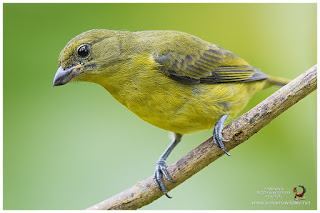Second visit
It took us until June to return to Paraíso, and again due to time constrains we were only able to spend one day there. Disregarding the short time we were able to spot some of the avian targets we were looking for, including species that are not easy to see in Panama, as the Ruddy Foliage-gleaner (Clibanornis rubiginosus) and the Costa Rican Brush-Finch (Arremon costaricensis). Unfortunately, as of the moment of these posts we have not been able to photograph these two.
Fiery-billed Aracari (Pteroglossus frantzii)
About Paraíso
At about 900 meters (2,950 ft) above sea level lays the Paraíso “corregimiento”, a locality of the
Boquerón District,
Chiriquí Province. It has a land area of 36.4 square kilometres (14.1 sq mi) and a population of around 400. It is not highland but is in the midway from the Boquerón District capital to the Volcano Barú and therefore lowlands and foothills’ specie converge, and due to its proximity to Costa Rica also regional endemic bird especies are not rare.
Paraíso location
Paraíso has been historically used to raise bovine cattle due to their fertile hills and numerous streams that constantly bring water from the highlands. Fortunately, the owners of the lands have preserved a lot of forest and gallery forest where a plethora of wildlife can still be found.
Currently, the contact to birdwatch in Paraíso is Mishael River, who you can contact by phone +507 6693-4236 or
facebook. You can hire him to guide you around the different birding places, including his cabin where he keeps some feeders to attract hummingbirds, tanagers and more.
Given the place is a paradise for birds, you can’t expect this post to have different class of animals but we promise that on next post you will see more than birds.
Black-hooded Antshrike (Thamnophilus bridgesi) - male
The species has apparently disappeared from many areas of Panama as a result of deforestation, but remains reasonably common in Paraíso.
Orange-billed Sparrow (Arremon aurantiirostris) is a resident of humid tropical forests from Oaxaca, Mexico south to northern Peru, at elevations from near sea level up to at least 1200 m. This medium sized finch is found in undergrowth habitats within primary and secondary forests, but occasionally ventures out onto paths or the edges of clearings. Forages on or near the ground. Usually hops over ground, sometimes scratching in leaf litter. Occasionally rises to low branch to glean an insect or pluck a fruit.
The female Orange-collared Manakin (Manacus aurantiacus) is green overall with yellowish underparts, and closely resembles females of many other manakin species. This species occurs in the understory of humid forest on the Pacific slope of southwestern Costa Rica and western Panama. In Panama it’s uncommon on western Pacific slope, from Azuero to Chiriquí to 750 m (2,500 ft) altitude, found in lower levels of forest edge, gallery forest, and woodland.
The Blue Dacnis (Dacnis cayana) females are green with powder bluish heads. It's found from Nicaragua to Panama, on Trinidad, and in South America south to Bolivia and northern Argentina. It is widespread and often common.
Olivaceous Piculet (Picumnus olivaceus) is distributed from Guatemala south to western Ecuador, extreme northwestern Peru, and northwestern Venezuela, this species is found in open forest and forest clearings. It is a tiny woodpecker with a very short tail that is not used for support as shown above. It’s uncommon on western Pacific slope, from Azuero to Chiriquí, and on eastern Panama on both slopes from the Canal Area to Darien, mainly below 1,200 m (4,000 ft) altitude. Found in lower and middle levels of forest edge. (female shown).
Red-crowned woodpecker (Melanerpes rubricapillus) - male
Thick-billed Euphonia (Euphonia laniirostris) - immature
Thick-billed Euphonia (Euphonia laniirostris) - female
Thick-billed Euphonia (Euphonia laniirostris) - males
Variable Seedeater (Sporophila corvina) - male
Variable Seedeater (Sporophila corvina) - female
Fiery-billed Aracari (Pteroglossus frantzii)
Lesson's motmot (Momotus lessonii)
Bran-colored Flycatcher (Myiophobus fasciatus) breeds from Costa Rica through South America to Bolivia, Uruguay, and Argentina. It also occurs on Trinidad. This species is found in open forests and secondary growth. Bran-colored flycatcher are sometimes difficult to see as they move rapidly through the undergrowth in search of small insects and berries. In Panama, it’s uncommon on Pacific slope from eastern Panamá Province to Chiriquí, and on Caribbean slope on Canal Area.
To be continued...























Best Dad T Shirts: Papa The Man The Myth The Bad Influence : http://bit.ly/2W0r82K
ReplyDeleteBest Dad T Shirts: Papa The Man The Myth The Bad Influence : http://bit.ly/2W0r82K
Best Dad T Shirts: Papa The Man The Myth The Bad Influence : http://bit.ly/2W0r82K
Best Dad T Shirts: Papa The Man The Myth The Bad Influence : http://bit.ly/2W0r82K
Best Dad T Shirts: Papa The Man The Myth The Bad Influence : http://bit.ly/2W0r82K
Best Dad T Shirts: Papa The Man The Myth The Bad Influence : http://bit.ly/2W0r82K
Best Dad T Shirts: Papa The Man The Myth The Bad Influence : http://bit.ly/2W0r82K